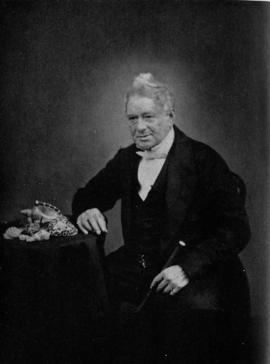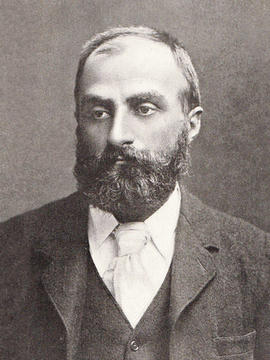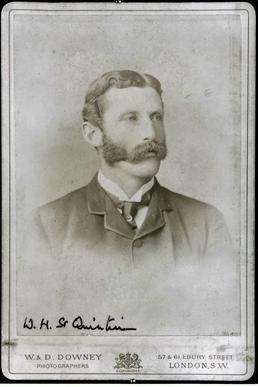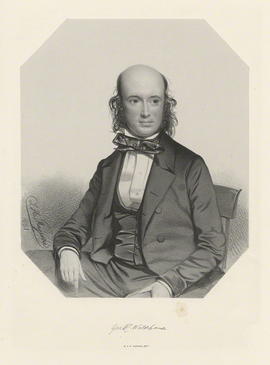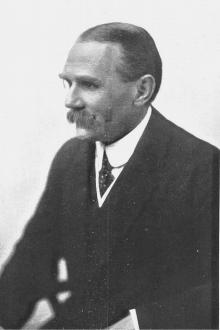Alfred Russel Wallace was a British naturalist, explorer, geographer, anthropologist, biologist and illustrator. He is best known for independently conceiving the theory of evolution through natural selection; his paper on the subject was jointly published with some of Charles Darwin's writings in 1858. This prompted Darwin the publish On the Origin of Species.
Hugh Cuming was an English collector who was interested in natural history, particularly in conchology and botany. He has been described as the 'Prince of Collectors'. Born in England, he spent a number of years in Chile, where he became a successful businessman. He used the money he saved to buy a ship that was specifically built for collecting specimens, and travelled extensively on collecting trips amassing many thousands of specimens. After his death, much of his material was bought by the Natural History Museum. A number of species are named after him
Morton Allport was an English-born Australian colonial naturalist. His work added largely to the knowledge of the zoology and botany of Tasmania. He was an authority on Tasmanian fish and catalogued, described and drew pictures of his specimens. He was a leader in the introduction of salmon and trout to Tasmanian waters and also introduced the white water-lily and the perch. He was a Fellow of the Linnean Society of London and of the Zoological Society of London. He was vice-president of the Royal Society of Tasmania
William Spiers Bruce was a British naturalist, polar scientist and oceanographer who organised and led the Scottish National Antarctic Expedition to the South Orkney Islands and the Weddell Sea
William Herbert St Quintin was a British naturalist. He was a keen ornithologist, keeping a private collection of birds including Great bustards, a secretary bird and a tui. He was a founding member of the Avicultural Society in 1895, president of the Yorkshire Naturalists' Union in 1909, a member of the British Ornithologists' Union from 1883 to 1922 and also served on the council of the Royal Society for the Protection of Birds from 1908-1919
George Robert Waterhouse was an English naturalist. He became interested in entomology though his father (an amateur entomologist) and he founded the Entomological Society of London along with Frederick William Hope in 1833 with himself as honorary curator. He became its president in 1849-50. The Royal Institution at Liverpool appointed him curator of its museum in 1835 and he exchanged this in 1836 for a position at the Zoological Society of London. His early work was on cataloguing the mammals at the museum and although he completed the work the next year, it was not published as he had not followed the quinary system of that time. He was invited to join Charles Darwin on the voyage of the Beagle but he declined it. On Darwin's return, the collection of mammals and beetles was entrusted to him. In November 1843 he became an assistant in the mineralogical department of the British Museum of Natural History. He became keeper in 1851 and held the position until his retirement in 1880. He was the author of A Natural History of the Mammalia (1846-48). He assisted Louis Agassiz with his Nomenclator Zoologicus.
Sir Frederick John Jackson was an English administrator, explorer and ornithologist. Jackson joined the British Ornithologists' Union in 1888. That year a paper by Jackson and Captain Shelley was published describing birds collected during his 1884-1886 trip to Africa. He collected many specimens in an 1898-1891 expedition to Uganda, and descriptions of this collection were published in a five-part paper in the Ibis in 1891-1892. Other papers described new species appeared in the Ibis and other journals between 1890 and 1917. Jackson was elected President of the East Africa and Uganda Natural History Society in 1910. He wrote nine of the nineteen chapters of Big Game Shooting, published in 1894. After retiring he worked on a complete history of the Birds of East Africa and Uganda, which was unpublished when he died in 1929, following pneumonia. The Birds of Kenya Colony and the Uganda Protectorate was completed by William Lutley Sclater
Wilhelm Karl Hartwich (or Hartwig) Peters was a German naturalist and explorer. He was assistant to the anatomist Johannes Peter Müller and later became curator of the Berlin Zoological Museum. Encouraged by Müller and the explorer Alexander von Humboldt, Peters travelled to Mozambique via Angola in September 1842, exploring the coastal region and the Zambesi River. He returned to Berlin with an enormous collection of natural history specimens, which he then described in Naturwissenschaftliche Reise nach Mossambique... in den Jahren 1842 bis 1848 ausgeführt (1852–1882). He replaced Martin Lichtenstein as curator of the museum in 1858, and in the same year he was elected a foreign member of the Royal Swedish Academy of Sciences. In a few years, he greatly increased the Berlin Museum's herpetological collection to a size comparable to those of Paris and London. Herpetology was Peters' main interest, and he described 122 new genera and 649 species from around the world
William Bernhardt Tegetmeier was an English naturalist, a founding member of the Savage Club, a popular writer and journalist of domestic science. A correspondent and friend of Charles Darwin, Tegetmeier studied pigeon breeds and the optimality of hexagonal honeycomb cells constructed by honeybees. He wrote a number of books dealing with home economics, poultry farming, pigeon breeds, bee-keeping and on the maintenance of livestock
Neave was a British naturalist and entomologist. He was the grandson of Sheffield Neave, a governor of the Bank of England and the father of Airey Neave. He was born in Kensworth, Hertfordshire, the son of Sheffield Henry M. Neave and his wife Gertrude Charlotte Margaret (nee Airey). He was educated at Eton and Magdalen College, Oxford.
Neave's first work was research into the problems related to the tsetse fly and the study of African animal life. He was part of the Geodetic Survey of Northern Rhodesia between 1904 and 1905. Between 1906 and 1908 he was part of the Katanga Sleeping Sickness Commission and then from 1909 to 1913 the Entomological Research Committee of Tropical Africa.
He returned to the United Kingdom in 1913 and was appointed Assistant Director of the Imperial Institute of Entomology, becoming Director from 1942-1946. He was appointed as an officer of the Order of the British Empire in 1933 and a companion of the Order of St. Michael and St. George in 1941. From 1918 until 1933 he was Honorary Secretary of the Royal Entomological Society and was then its President in 1934-1935.
In 1934 he had the idea to compile an updated index of all published generic and subgeneric names in zoology, an activity which occupied the period 1935-1939, and resulted in the publication of his (initially) four volume 'Nomenclator Zoologicus' in 1939-1940. He also oversaw the preparation of a fifth volume, published in 1950.
Neave was Secretary of the Zoological Society of London from 1942. He retired in 1946 but carried on as Honorary Secretary until 1952.
Naeve married twice, firstly to Dorothy Middleton and they had two sons and three daughters, the eldest was Airey Neave, later a Member of Parliament. Dorothy died in 1942 and Neave married a second time to Mary Hodges in London in 1946.

